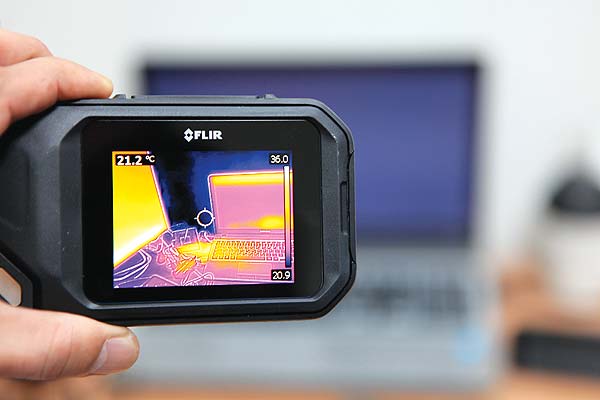
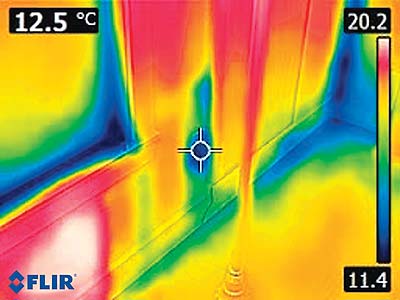 Thermal imaging cameras are handheld electronic devices with an integrated visual display, designed for detecting heat energy.The key component of a thermal camera is a heat sensor attached to a special type of lens, which is then adapted to work alongside standard image-capture technologies. This allows engineers to quickly identify regions of excessive temperature or sources of wasted heat energy, such as overheating components or potential thermal insulation gaps in building inspection.
Thermal imaging cameras are handheld electronic devices with an integrated visual display, designed for detecting heat energy.The key component of a thermal camera is a heat sensor attached to a special type of lens, which is then adapted to work alongside standard image-capture technologies. This allows engineers to quickly identify regions of excessive temperature or sources of wasted heat energy, such as overheating components or potential thermal insulation gaps in building inspection.
On a colour thermographic display, warmer components or regions will show up as reds, oranges and yellows, while cooler parts will typically be shown as purples and blues (green usually indicates areas that are roughly at room temperature). Because they measure infrared radiation, and not visible light, thermal cameras are also useful for identifying heat sources in very dark or otherwise obscured environments.

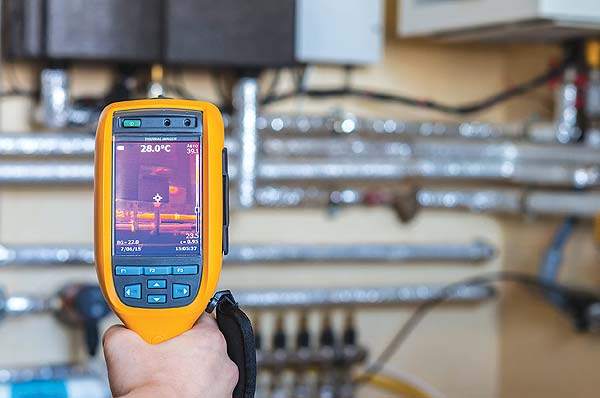 How thermal imaging cameras work?
How thermal imaging cameras work?
An infrared, IR or thermal imaging camera works by detecting and measuring the infrared radiation emanating from objects – in other words, their heat signature.
In order to do so, the camera must first be fitted with a lens that allows IR frequencies to pass through, focusing them on to a special sensor array which can, in turn, detect and read them.
The sensor array is constructed as a grid of pixels, each of which reacts to the infrared wavelengths hitting it by converting them into an electronic signal. Those signals are then sent to a processor within the main body of the camera, which converts them using algorithms into a colour map of different temperature values. It’s this map which is sent on to be rendered by the display screen.
Many types of thermal imaging camera will also include a standard shooting mode that works with the visible light spectrum, much like any other point-and-click digital camera. This allows for easy comparison of two identical shots – one in IR and one in normal mode – to help quickly identify specific problem areas once the user steps out from behind the lens.
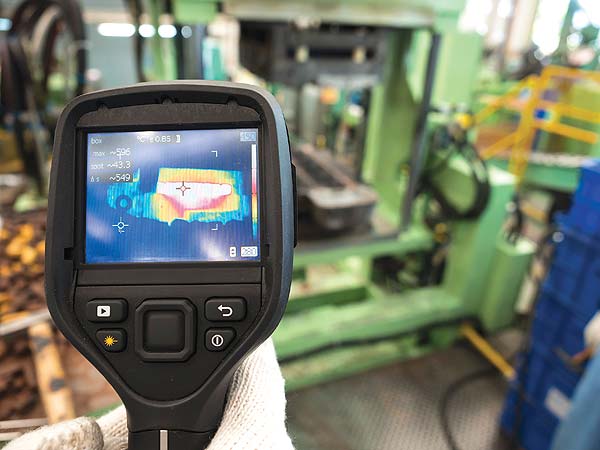
 Uses of thermal imaging cameras:
Uses of thermal imaging cameras:
Industrial infrared cameras
Many current thermal imaging cameras are certified specifically for industrial use, with various different configurations and manufacturing standards.
Thermal Imagery for buildings
Instruments designed for use in buildings are typically used to detect issues within the fabric of construction, and for problems that may be obscured from view or behind walls.
Applications include checking the effectiveness of insulation, detecting moisture and leaks, testing underfloor heating systems and central heating appliances, and tracking down leaks from ventilation channels.
RS PRO RS700 Thermal Imaging Camera, Temp Range: -20° +150°C, -4° +302°F 80 × 80pixel
RS Stock # 136-5667
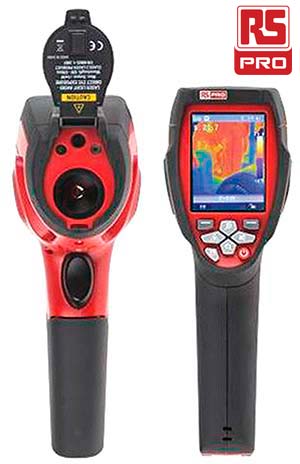 RS Pro thermal Imaging camera is an easy to use thermal camera for fast and efficient thermal imaging using infrared technology. Ideal for electrical and construction in both work and inspections, this thermal camera can detect leaks in pipes, and provides data about a buildings energy efficiency and any defects.
RS Pro thermal Imaging camera is an easy to use thermal camera for fast and efficient thermal imaging using infrared technology. Ideal for electrical and construction in both work and inspections, this thermal camera can detect leaks in pipes, and provides data about a buildings energy efficiency and any defects.
Combining all the important features for thermographic measurement at an affordable price, it also features automatic hot/cold detection. With a built-in digital camera it also allows video and sound recording, USB data transfers for Live video and Wifi for data to mobile devices. The RS700 is safe, accurate, quiet, fast, reliable and robust enough to withstand tough daily use.
Thermal images are essential for identifying corroded connections, defects in electrical equipment, overheated motors and potential fire hazards. Included with this article are an adaptor, battery, Micro SD 8GB card, USB cable, USB OTG cable, warranty card, PC software installation CD and a carrying case.
Features and Benefits:
• Display: 2.8″ LCD, 240 × 320 pixels
• IR Resolution: 80 × 80 pixels
• Image Frequency: 50 Hz
• Battery Operating Time: Approx. 4 hours
• Integrated LED Light
• Built-in lens cover
Supplied with:
Thermal Imager, Lens, Li-ion battery, Adaptor, Micro SD 8 GB card, USB cable, USB OTG (On The Go) cable, PC software Installation CD, Carrying case
FLIR C3 Thermal Imaging Camera with WiFi, Temp Range: -10 → +150°C 640 × 480pixel
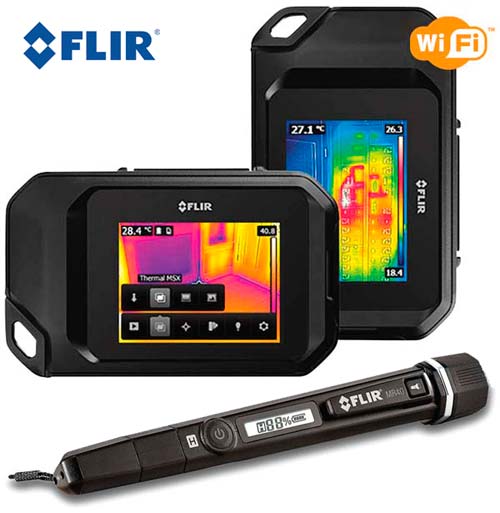 RS Stock # 180-8514
RS Stock # 180-8514
Mfr. Part # C3+MR40
The FLIR C3 thermal camera is designed to assist with building inspections, facilities maintenance, HVAC, or electrical repair. This slim camera fits easily into users pockets making it a fully portable thermal imaging device. Its integrated touch-screen is user friendly, allowing fast and reliable access to finding hidden problems, documenting repairs, and sharing images over Wi-Fi. Featuring a tough rubber exterior and reinforced buttons this infrared camera is extremely durable in harsh environments.
Features and Benefits:
• IR Resolution 80 × 60
• Digital camera 640 × 480 pixel
• 3″ colour display 320 × 240 pixels
• Image mode: Thermal, visual, MSX®, Picture-in-Picture
• Operating temperature –10°C to 50°C (14°F to 122°F)
• Vibration and red LED alarms alert users to the presence of voltage in noisy areas
• Versatile high/low sensitivity modes detect voltage on industrial equipment and low-voltage installations
• Powerful LED worklight always at the ready to illuminate poorly lit locations
• Inspection light at the probe tip facilitates testing in dark areas
Author: Bogdan Grămescu,
Aurocon COMPEC authorised distributor for RS Components


